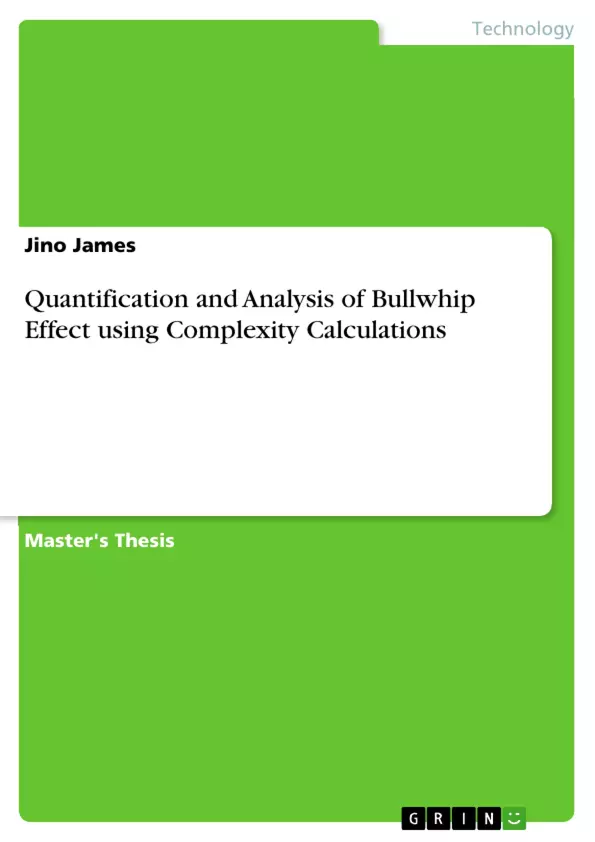Increasing demand from customers, high market competitions, fluctuating demand from customers and faster response, in addition to advancements in technology have turned the market into an unstable environment. All this conditions together creates a greater uncertainty in the supply chains and leads to the bullwhip effect phenomenon. It happens when the orders to the supplier tends to have larger variations than demands to the buyer such that the distortion propagates upstream in an amplified form. The major problems associated with the bullwhip effect are increasing the safety stock & carrying cost at each supply chain echelon, decreasing the customer satisfaction and inefficient production process at each echelon.
So it is important to identify the bullwhip effect associated with the supply chain. One of the important step in analyzing the bullwhip effect is the quantification of bullwhip effect in an accurate way. Usually bullwhip effect is calculated as a ratio between order variance to the demand variance. This method is used by assuming that the variables in the data sets are independent and identically distributed. But in actual practice the data associated with the order and sales shows some kind of dependency within the data set. This independency is represented by a parameter known as Hurst exponent, which is identified by methods of rescaled range analysis, detrended fluctuation analysis (DFA) etc. A better method for the quantification and analysis of bullwhip effect is introduced in this paper by considering the independency of data set.
Table of Contents
- CHAPTER 1. INTRODUCTION
- 1.1. Bullwhip Effect
- 1.2. Complex Systems
- 1.3. Hurst Exponent
- 1.4. Importance of The Topic
- CHAPTER 2. LITERATURE REVIEW
- CHAPTER 3. METHODOLGY
- 3.1 Data collection
- 3.2 The Present Method
- 3.3 The Proposed Method
- 3.4 Hurst Exponent Calculation
- 3.5 Lyapunov Exponent
- 3.6 Matlab Software
- CHAPTER 4. COMPUTATIONL RESULTS AND ANALYSIS
- 4.1 Variance Change as a Function of H
- 4.2 Variance Change as a Function of Number of Data
- 4.3. Hurst Exponent Calculation from Data
- 4.4 Lyapunov Exponent Calculation from Data
- CHAPTER 5. CONCLUSION AND FUTURE WORKS
- REFERENCES
Objectives and Key Themes
This thesis investigates the quantification and analysis of the bullwhip effect in supply chains, leveraging complexity calculations. The primary aim is to develop a more accurate method for quantifying the bullwhip effect by considering the dependency within data sets, which is often overlooked in traditional approaches.
- Quantification of the Bullwhip Effect
- Analysis of Bullwhip Effect Using Complexity Calculations
- The Role of Hurst Exponent and Data Dependency
- Application of Detrended Fluctuation Analysis (DFA)
- Impact of Data Dependency on Supply Chain Dynamics
Chapter Summaries
Chapter 1 introduces the concept of the bullwhip effect, emphasizing its significance in unstable market environments. It also explains the relevance of complex systems and the Hurst exponent in analyzing supply chain dynamics. Chapter 2 provides a comprehensive review of existing literature on the bullwhip effect, outlining previous research and methodologies. Chapter 3 delves into the methodology employed in this thesis, including data collection, the proposed method, and the calculation of the Hurst exponent using techniques like rescaled range analysis and detrended fluctuation analysis. Chapter 4 presents computational results and analysis, exploring the variation of variance based on the Hurst exponent and data size. It also details the calculation of the Hurst and Lyapunov exponents from data related to different product categories, such as computer consumables, automotive components, washing powder, and fresh juice.
Keywords
The key concepts and terms explored in this thesis include the bullwhip effect, complexity calculations, data dependency, Hurst exponent, detrended fluctuation analysis (DFA), rescaled range analysis, Lyapunov exponent, and supply chain dynamics.
- Arbeit zitieren
- Jino James (Autor:in), 2020, Quantification and Analysis of Bullwhip Effect using Complexity Calculations, München, GRIN Verlag, https://www.grin.com/document/917534



